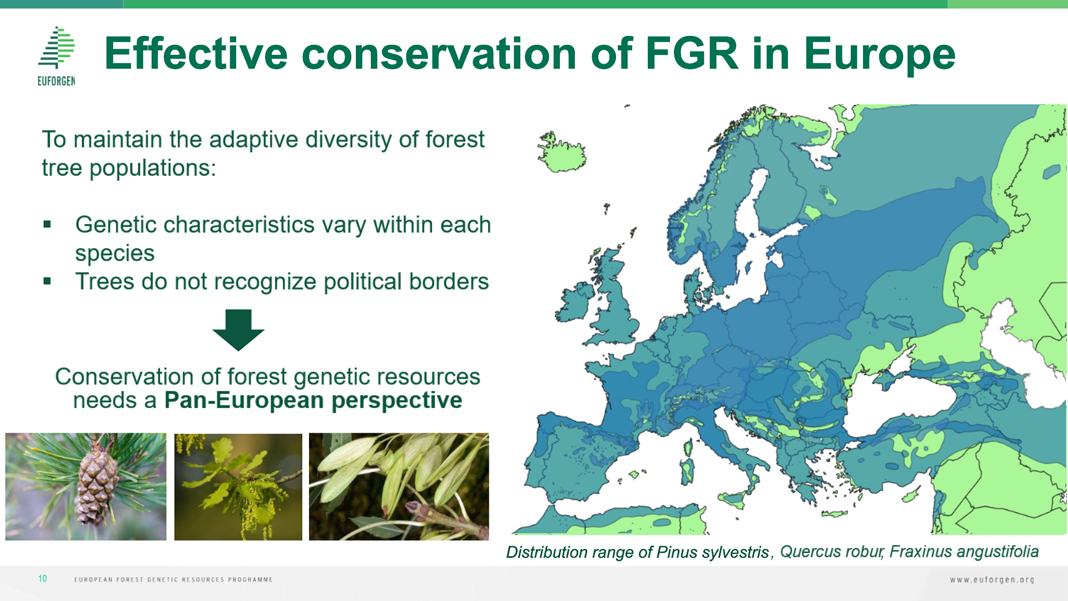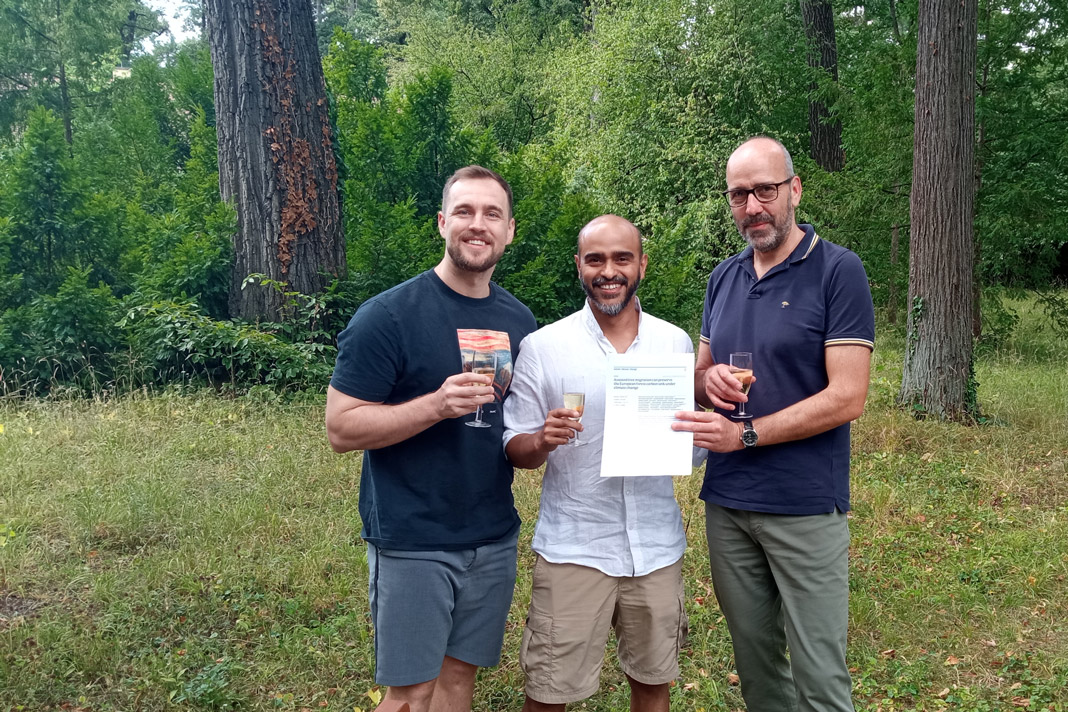EUFORGEN & Forest Europe Webinar: Forest Genetic Resource conservation as part of Sustainable Forest Management
As countries in Europe begin the process of implementing recently agreed requirements for strict environmental protection of old-growth forests, potential conflicts with the need to conserve forest genetic resources might arise. EUFORGEN and Forest Europe organised a webinar in October to address these concerns.
Conservation of forest genetic resources (FGR), especially as part of the concept of Sustainable Forest Management, has proven to be an issue of great importance for the potential adaptation of European forest species to the challenges of climate change and its adverse effects. Since the early 1990s, Forest Europe has stressed the importance of conserving forest genetic resources for sustainable forest management and through EUFORGEN, the implementation mechanism of the Forest Europe process, the conservation of these resources in Europe is coordinated through a network of Genetic Conservation Units (GCUs).
The webinar "Manage to Conserve - Forest Genetic Resource conservation as part of Sustainable Forest Management" organised on 11 October by Forest Europe and EUFORGEN aimed to put on the agenda and to discuss some environmental, social and political challenges for the adequate conservation of forests' genetic resources, focusing on some cases such as the protection of old-growth forests, which may prevent human intervention and thus lead to the loss of entire forest populations and their genetic diversity.
The session consisted of two keynote speeches: one entitled "Why is the policy framework key to support SFM as a basis for the availability, conservation and sustainable use of Forest Genetic Resources?" given by Jens Hartel from Forest Europe and another presentation led by Anna Maria Farsakoglou, researcher at the EUFORGEN secretariat, entitled "What will the Strategy for the Conservation of Forest Genetic Resources do for a successful adaptation of European forests to climate change?".
These presentations were followed by a panel discussion with guest experts including Felipe Pérez Martín (Ministry for Ecological Transition and Demographic Challenge - MITECO, Spain), Mari Rusanen (Natural Resources Institute Finland - Luke, Finland), Marjana Westergren (Slovenian Forestry Institute -GIS, Slovenia), Brigitte Musch (French National Forestry Office - ONF, France) and Peter Löffler (Directorate-General for Climate Action - Adaptation and Resilience to Climate Change of the European Commission). The webinar was facilitated by science communicator Jeremy Cherfas.
The importance of genetic conservation for global forest challenges
During the webinar and panel discussion, different approaches to the conservation of forest genetic resources were addressed. In the first section of presentations, the EUFORGEN Secretariat researcher Anna Maria Farsakoglou highlighted that “Genetic Conservation Units (GCUs) management maintains the long-term viability of the forest tree populations”. And in this line, she added:
“When a GCU is located in an old-growth forest, intervention should be allowed to conserve the existing genetic diversity”.
The participants were also informed during the meeting that EUFORGEN has embarked on a consultative process to develop a report on “Adaptation of Genetic Conservation Units to Climate Change,” which will offer evidence-based guidelines for effective management. Jens Haertel, policy advisor at FOREST EUROPE, emphasised the importance of this report: “Its integration in the context of the work towards the Forest Risk Knowledge Mechanism (FoRISK) is key”.
Genetic conservation units are at the heart of conservation strategies for forest genetic resources (FGR). They form a pan-European network of sites where populations of tree species can continue to evolve in response to challenges such as climate change. This makes them an important reservoir of genetic diversity. Differences between individuals within a population confer different capacities to withstand, for example, drought or higher temperatures. As Marjana Westergren, a scientist at the Slovenian Forestry Institute, explained:
“Genetic diversity is the foundation of species and ecosystem biodiversity and is the fuel for adaptation to climate change, pests and diseases”.
Conservation of GCUs ensures that this diversity will be available in future. However, many GCUs are part of forests that could be classified as old-growth forests. It is therefore important that strict conservation does not prevent management of GCUs.
As an example of necessary management, Mari Rusanen, who is responsible for the National Programme on FGR conservation of Finland, pointed out that genetic conservation depends on abundant flowering and regeneration to create genetically novel adapted individuals.
“Interventions must be allowed for keeping the forest in good health and getting plenty of seedlings for the future forest,” she said.
Genetic adaptation to change takes place when individuals reproduce and better-adapted offspring survive. If change is particularly rapid, shorter intervals between generations will speed adaptation. That too requires management, said Marjana Westergren. “Certain silvicultural measures may induce seed production and facilitate natural regeneration,” she said. “They can also contribute to a more diverse regeneration.”
Looking towards a future of shared objectives
Awareness and dialogue will be important going forward to promote clarity and mutual understanding. Those responsible for implementing strict protection should appreciate the importance of genetic conservation units for the well-being of all forests. The management of GCUs for their long-term future will not harm old-growth forests and may well enhance them.
Felipe Pérez, Head of Forest Genetic Resources in Spain, suggested that it might be advisable for biodiversity conservation authorities to be consulted on the development of some GCU management plans. Likewise, experts on the dynamic conservation of forest genetic resources could share their knowledge with biodiversity conservation.
Brigitte Musch, who is responsible for the conservation of forest genetic resources at the National Forest Office in France stressed:
"The conservation of genetic resources requires regular interactions between ecosystem conservation and genetic resources stakeholders. Their objectives within the same ecosystem may be opposed but often they can complement each other".
While it is possible that strict protection for old-growth forest could possibly prevent the management of GCUs, there is absolutely no need for that to be the case. Peter Löffler, Policy Officer in DG Climate of the European Commission, pointed out that the conservation of forest genetic resources and the protection and restoration of old-growth forests have overlapping objectives:
"EU rules for ‘strict protection’ allow activities that are necessary to restore the natural values of protected areas. It should therefore be possible to find compromises and to reconcile the two objectives in most cases".








